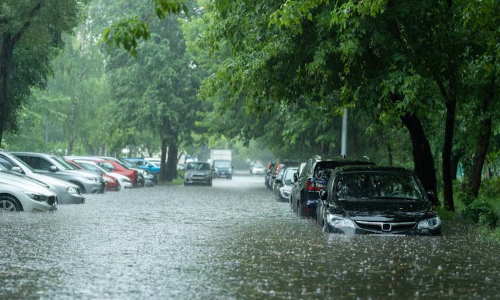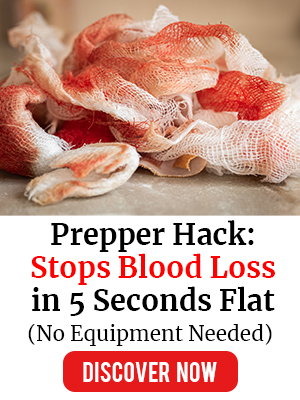
This article was originally published by Bob Rogers on www.survivopedia.com
In the last decade or so, it seems that a lot of people became aware of the need for a survival plan, and this became an even more demanding reality when the pandemic hit. Today, hurricanes, wildfires, and social unrest are all real possibilities that we have to face.
The environment plays a critical role in your survival, and no other environment is more challenging than the urban setting when it comes to survival. In fact, the idea of being trapped in an environment with a high social density is something a lot of folks refuse to think about.
I’ve always considered “city life” to be detrimental to our survival instincts, and a catastrophic event can trap everyone inside an urban climate, regardless if they are an expert prepper or average Joe. You could spend years planning for everything you fear may one day occur and developing the best bug-out plan, but the hostile and dangerous characteristics of urban environments can ruin all your plans and preparations.
The dangers of urban environments
The city you live in, like most cities all across the country, experiences a vast and unique set of issues that make them a dangerous place to be in when a crisis occurs. Staying in the city is a difficult and challenging effort.
First of all, you have to understand that everything city dwellers need to survive and live comfortably in the city is delivered from other regions. There are almost no renewable resources in the city, and those resources that are available could be unavailable if the disaster affects the transportation routes, vehicles, manpower, etc. Once these supplies are gone, there will be no alternative to resupplying, and people will start to turn on each other.
Second, the population of the city is an unpredictable factor that plays an important role in every survival scenario. The presence of desperate people will lead to panic, and panic is highly contagious. As panic spreads, it will lead to social upheaval, a mob mentality will form and take over, and innocent people will get hurt.
And lastly, you have to assume that no help is coming and there will be no one to give you a helping hand. A lot of people falsely believe that some form of government will come to their aid in case a natural disaster occurs. But as we saw during Hurricane Katrina, there simply isn’t enough to go around, and government agencies lack the manpower and logistics to handle large-scale disasters.
What can you do?
I believe that people living in the city should consider a few key factors when making their survival plan. The time period of the aftermath of a disaster, the supplies they have or are able to procure, the movement factor, and defense preparations.
The aftermath of the disaster
The aftermath of a disaster oftentimes can and will affect not only the individual but the entire community. The aftermath can be temporary or permanent.
Temporary aftermath can also be divided into short-term and long-term types. Most Americans have already experienced short-term aftermath, and these are fairly common in first-world countries. One example would be the common blackout a lot of people experience after a storm or system/grid failure.
Some of these aftermaths have effects that are nothing more than an annoyance to most people, while others have lasted longer than expected. One example would be a shortage of gas that affects not only the individual when the fuel pumps run dry but also the community when the re-stocking of goods takes longer than usual.
Long-term effects are still temporary, but they can last for several weeks or months. In this category, we can include major natural disasters, civil unrest, and even war. These scenarios create various issues that often lead to people turning on each other as soon as the lack of resources affects their lifestyles. In the case of temporary short-term aftermath, people usually come together and help each other because they know such situations don’t usually last long, and there’s no panic involved.
Permanent aftermath is caused by an event that has lasting change and makes an area inhospitable. Even experienced preppers may have a hard time surviving and living through such conditions, and one “recent” example would be Hurricane Katrina. Other historical effects whit long-lasting and permanent effects that are worth mentioning are the Dust Bowl and Great Depression.
General supplies
Urban preppers and city dwellers will have a hard time procuring food and water, and various other needed items if they don’t store them long before the disaster hits. Stockpiling various resources is an important part of any survival plan. You need to make sure you have the right stuff you need to survive for a reasonable amount of time, but more on this later.
Movement
Being able to move undetected is something most people can’t even think about, let alone practice. Movement plays an important role in the aftermath of a disaster if you live in the city because it will help you navigate successfully when you need to scavenge for supplies or evacuate.
Defense
In the city, defense and general supplies are equally important because evasion won’t always be possible. You will need various firearms and firearms accessories and the means to secure the perimeter. This is a complex endeavor, and the use of force should be limited and employed only as a last resort.
How to prepare
If you live in the city, preparation is subjective, and it mainly depends on the skills you have, available resources, and storage room. Storage room is finite in an urban setting, and it’s one of the biggest problems you have to deal with since storing enough food and water is an impossible task for many.
When it comes to general supplies, you should have at least a month’s worth of food and water. The food items you pick should be highly nutritious and as compact as possible. A lot of urban preppers prefer to stockpile MREs because these take less space than other food items, and they have a long shelf life.
However, storing water is the main challenge here because water is both heavy and bulky. You need to store enough water for drinking, cooking, and sanitation. One suggestion is to look into water pouches that can be filled with water and stored in the bathtub, like the waterBob. This is a last-minute solution that can help you store a large quantity of water. Of course, you also need to have water stored in your house and not wait until the last minute to figure out how much water you can collect from various sources.
I know people who are storing water and food in storage boxes or various caches throughout the city, and they will use those supplies when needed. While this may seem like a good idea, you also have to consider the fact that you may not be able to reach those supplies or that someone else will beat you to them. And here is where movement plays an important role.
Arriving at or leaving from certain locations may be necessary if you live in the city since you will need to stay well-stocked on food and other provisions. You may need to travel to and from your caches, or you may be forced to organize trips to scavenge for whatever resources may still be available. There are two approaches when it comes to movement, and both are subjective to the situation at hand.
How will you survive when there is no doctor around?
If there is no danger and social upheaval is not yet a problem, you have to blend in with the people and the environment. Here is where having gray man skills comes into play, and we’ve covered this topic a few times here at Survivopedia. If you do supply runs and want to blend in, make sure you make more than one trip and never use the same route. It will be much easier carrying the supplies (and running, if needed), and you will not stand out like when carrying a bulky backpack.
The second approach is the one where you have to stay out of sight, under the radar, sort of speaking. This will require you to make a schedule and note when people are most active in your area because this schedule can vary from one situation to another. Even looters get tired and will return to their homes in the first hours of the day. Note when you have to go out and schedule your trips based on your needs because retrieving items from a cache is less dangerous than scavenging for resources at grocery stores, pharmacies, and other locations where competition may always be present.
Defending yourself and what’s yours
When it comes to making a defense plan, you must keep in mind the following, personal defense, location defense, and group defense. Here some may argue about which firearms they should get, how much ammo to store, and so on, but the truth is that you need to be able to put to good use whatever firearm you own and whatever perimeter defense methods you implement.
You will need to carry a weapon to protect yourself when “running errands,” and you need to make sure you can properly conceal it. You will need to make sure your home is protected and give yourself enough warning time (which means slowing/delaying an attacker) to deal with a threat.
The problem with an urban climate is that there are more threats to deal with than you can possibly handle, and sooner or later, you will have to decide if it’s worth defending what’s yours at all costs or leaving everything behind and seeking safety elsewhere.
Depending on the environment, it may also be possible to seek aid from others. Here is where group defense can help, but it all depends on your environment and the connections you make within the community. You may be able to put together a group of people to defend the block, but you need to remind yourself that nothing good lasts forever.
Bugging out will always be an option
Yes, bugging out is always an option, but you have to ask yourself if it’s the ideal option for your situation. If you have enough supplies and the help/support of your neighbors, perhaps it’s not such a good idea to hit the road and head for the woods. Some survival experts suggest moving to a secondary location, somewhere closer to the exterior of the metropolitan area, and they even advise storing your supplies there.
However, you should keep in mind that social environments like large cities will cannibalize themselves from the inside out, and once nothing of value can be obtained from a specific area, people will start migrating, eventually reaching your secondary location. It’s in our nature to migrate to greener pastures when we are no longer able to sustain ourselves in a specific environment.
Ideally, one should have a bug-out location outside of the zone affected by the disaster and seek help from relatives and friends located in other states. Here, once again, it really depends on the aftermath of the event and the supplies you have or are able to acquire without taking unnecessary risks.
Concluding
A lot of urban preppers have some essentials in place, and they also have a backup plan for when their bugging-in plan is no longer feasible. In the event of a serious natural disaster/emergency situation with extended aftermath, it is better if you lay low for a while and hunker down for as long as possible.
You also need to understand that once supplies run low, you will need to have a plan to remain well-stocked or move to a secondary location.



One Reply to “How to survive the aftermath of urban disasters”